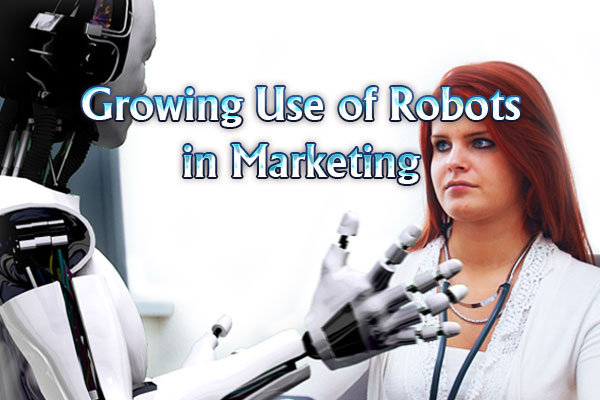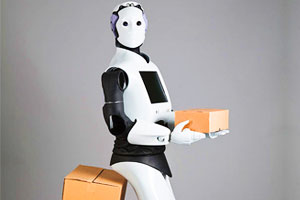1111Perhaps humanity is still far from applying the Voight-Kampff tests (a la Blade Runner) to distinguish between an android and a human being, but it is a fact that robots are a part of our lives now.
For many, the presence of robots goes unnoticed; however, right now a software-driven robot (better known as “spider”) makes articles appear on your search results page analyzed out of the millions of pages and ranked and presented to you. Elsewhere, an industrial robot works very close to humans, assembling parts, moving materials and other tasks in some automotive factory.
It may even be that some of us woke up this morning after a cheerful and gentle notice on our mobile device, which announced that we had a new notification of an email coming from a blog, website or brand of which we are fans. And so without knowing it, a robot that is dedicated to marketing disturbed our dreams and made us take action.
 Robots in Marketing – Automated Marketing with AI and Software Robots
Robots in Marketing – Automated Marketing with AI and Software Robots
The use of robots in marketing is not something new, it has been progressing for years, and this has helped to automate, optimize resources and measure the results of various tasks. It is precisely from the ability to program marketing actions that we now have the term, marketing automation.
Some examples of this type of automated marketing through software robots include:
- Programming automated email marketing campaigns – sending targeted automated emails to clients and prospects based on analysis of data
- Segmentation of prospects based on big data analysis
- Generation of custom workflows for interacting with prospects
- Programming messages and publications in social networks and blogs – scheduling posts for publication at a particular time based on data inputs about things such as current use events, active discussion topics and other data that can be analyzed. A key component of many marketing automation software systems is the constant collecting of data for input into complex analysis process that can then be used for marketing programs.
However, with robots and automation, there are also some challenges:
- The belief that the results of marketing automation are always the best result. This can lead to spam and/or wasted marketing efforts and budgets.
- Believing that the acquisition of marketing automation software will bring huge results per se, forgetting the strategy and planning, which must be done by humans. We aren’t at the point where the entire marketing life cycle can be automated.
 Robots in Marketing –Physical Interaction
Robots in Marketing –Physical Interaction
Physical robotics technology has developed with the aim of helping human beings perform specific tasks and needs; robots are part of this goal, and as such, for years we have been able to perform mechanical tasks more effectively, reducing the error margin, improving productivity and more. Robotics is becoming commonplace for example in our auto manufacturing processes.
Robots are being tested at some Target stores to roam store floors and survey shelf conditions, take stock of inventory and help to ensure the store is presentable to the potential customers. With the ability to check thousands of SKUs faster and more accurately than human workers, robots can have a significant impact on reducing revenue loss and customer frustration caused by out-of-stocks or misplaced items.
Additionally, as they travel the floor checking shelf conditions they can also capture real-time data on shopper behaviors. Using computer vision, video analytics, and other technologies, robots can capture data on how shoppers move through the store, where they are congregating and what products they are purchasing. They can even examine shoppers’ facial expressions for insights into consumer sentiment and their decision making processes. When combined with analytics, this data yields powerful, real-time insights and provides retailers the opportunity to send an associate to help the shopper, or send a personalized offer to the shopper’s mobile phone, or take other actions to give the shopper exactly what they need at that moment.
Robots are also being used at some select “big box” stores to help customers find items within large inventories. Shoppers can tell the robot what they’re looking for – a specific type of crew, for example – and have the robot guide them to its exact location on the shelf, Walmart is testing the use of robotic shopping carts that not only help shoppers find items on their list but also eliminate the need to push a heavy cart through the store. This can be especially helpful for customers with disabilities.
Other examples include Pepper, a charming, humanoid robot that greets customers in. It can read a variety of customers’ emotions, respond to their inquiries and make recommendations based on its interactions with them.
While some people have expressed concern over the prospect of robots replacing human workers, retailers actually gain the greatest benefits by using robots to augment and complement the human workforce. Robots can offload the more tedious and repetitive tasks, thereby freeing up staff to focus their efforts on more skilled work, such as “client ling” and building loyal relationships with customers.
To join the robotics revolution, retailers will need to have an IT architecture that supports pervasive, robust wireless connectivity, data collection and aggregation, flexible cloud computing, edge analytics, mobility, and more. They will also benefit from precision indoor location technology, which helps a robot navigate and pinpoint targeted customers, shelves, or merchandise.
What is the future of automated marketing?
For now, we can say that the relationship of both software and physical robots and marketing is just getting started. As humans, we all hate the automated voice prompt messages and feeling like we are stuck in a system. It will be interesting to see where the technology leads us and how close we will come to having fully interactive marketing experiences with robots.


 Robots in Marketing – Automated Marketing with AI and Software Robots
Robots in Marketing – Automated Marketing with AI and Software Robots Robots in Marketing –Physical Interaction
Robots in Marketing –Physical Interaction